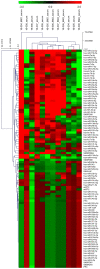Significant Changes in Serum MicroRNAs after High Tibial Osteotomy in Medial Compartmental Knee Osteoarthritis: Potential Prognostic Biomarkers
- PMID: 33562261
- PMCID: PMC7914593
- DOI: 10.3390/diagnostics11020258
Significant Changes in Serum MicroRNAs after High Tibial Osteotomy in Medial Compartmental Knee Osteoarthritis: Potential Prognostic Biomarkers
Abstract
High tibial osteotomy (HTO) is an effective alternative for medial compartmental knee osteoarthritis (OA). Circulating microRNAs (miRNAs) are known to serve as OA-related biomarkers. The present study investigated the differential expression of serum miRNAs before and after HTO to identify potential miRNAs as prognostic biomarkers. miRNA-polymerase chain reaction (PCR) arrays were used to screen for miRNAs in the serum at preoperative and 6-month postoperative time points from six patients, and the differentially expressed miRNAs identified in the profiling stage were validated using real-time PCR at post-operative months 6 and 18 in 27 other HTO-treated patients. Among 84 miRNAs involved in the inflammatory process, three (miR-19b-3p, miR-29c-3p, and miR-424-5p) showed differential expression patterns in the profiling stage (p = 0.011, 0.015, and 0.021, respectively). Levels of these three and four other miRNAs (miR-140-3p, miR-454-3p, miR-let-7e-5p, and miR-885-5p) known to be related to OA progression were evaluated in the serum of 27 patients. Only four miRNAs (miR-19b-3p, miR-140-3p, miR-454-3p, and miR-let-7e-5p) were significantly upregulated at postoperative month 6 (p = 0.003, 0.005, 0.004, and 0.004, respectively), and only miR-140-3p was significantly upregulated up to 18 months after operation (p = 0.003). Together, this study reveals the significantly upregulated serum miRNAs after HTO as potential prognostic biomarkers; however, further studies are warranted to elucidate their clinical implications.
Keywords: high tibial osteotomy; knee; medial compartmental osteoarthritis; prognosis; serum miRNA.
Conflict of interest statement
The authors declare no conflict of interest.
Figures



References
-
- Niemeyer P., Schmal H., Hauschild O., Von Heyden J., Sudkamp N.P., Kostler W. Open-wedge osteotomy using an internal plate fixator in patients with medial-compartment gonarthritis and varus malalignment: 3-year results with regard to preoperative arthroscopic and radiographic findings. Arthroscopy. 2010;26:1607–1616. doi: 10.1016/j.arthro.2010.05.006. - DOI - PubMed
-
- Prodromos C.C., Amendola A., Jakob R.P. High tibial osteotomy: Indications, techniques, and postoperative management. Instr. Course Lect. 2015;64:555–565. - PubMed
Grants and funding
LinkOut - more resources
Full Text Sources
Other Literature Sources

